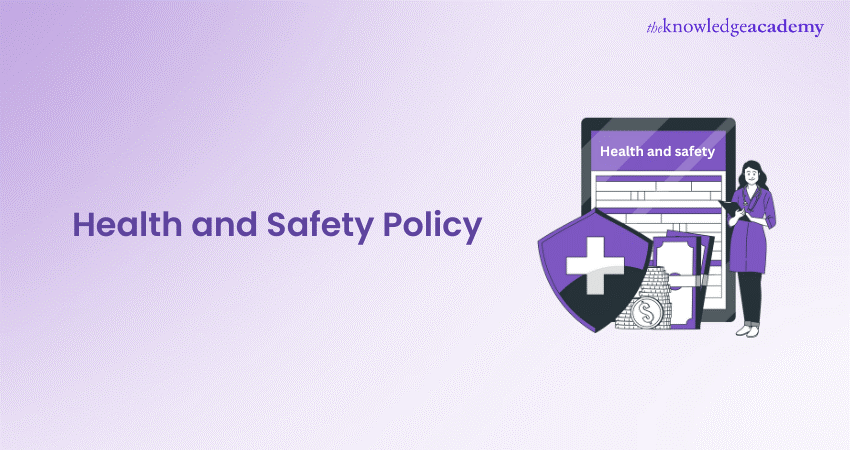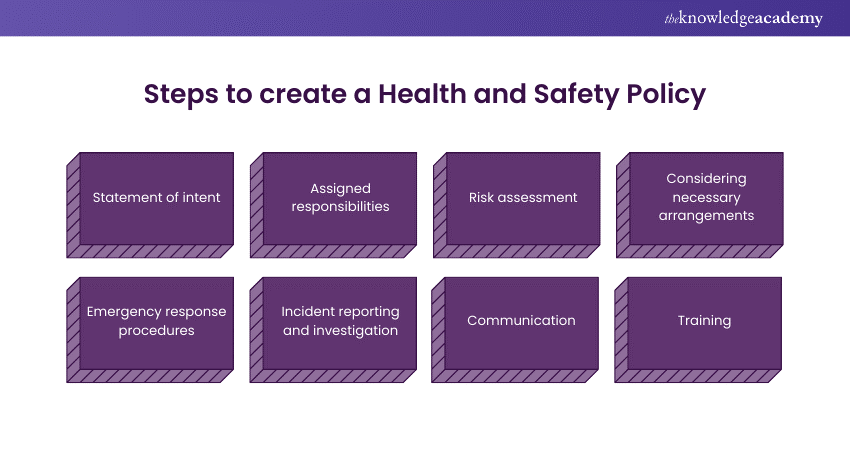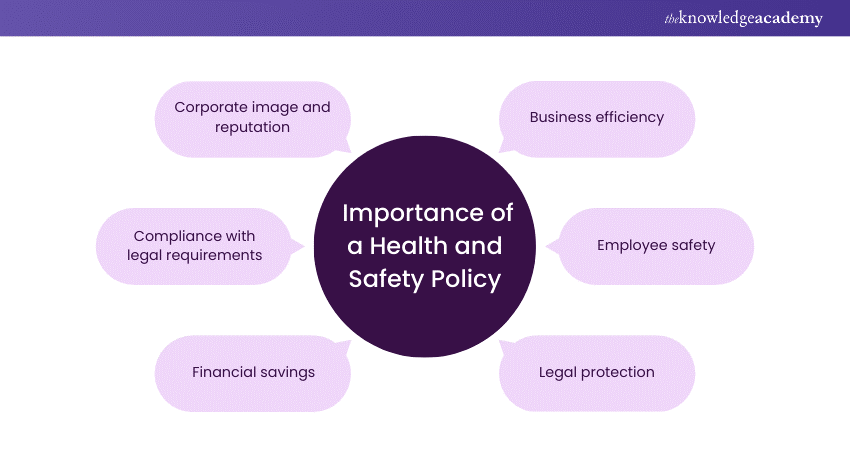We may not have the course you’re looking for. If you enquire or give us a call on 01344203999 and speak to our training experts, we may still be able to help with your training requirements.
Training Outcomes Within Your Budget!
We ensure quality, budget-alignment, and timely delivery by our expert instructors.

Every workplace highly prioritises the well-being of employees. Their well-being also leads organisations to adopt Health and Safety Policy for all. In addition, this comprehensive Policy safeguards employees from potential and provides guidelines to prevent those concerns.
The Health and Safety Policy focuses on identifying, assessing and addressing the potential hazards that might arrive at a workplace. You can read this blog to delve into what this Policy entails, why it's essential, how it's developed, and its implementation in the workplace.
Table of Contents
1) What is a Health and Safety Policy?
2) Crucial elements of a Health and Safety Policy
3) Steps to create a Health and Safety Policy
4) Importance of a Health and Safety Policy
5) When and how to review the Policy?
6) Effective implementation of the Policy
7) Conclusion
What is a Health and Safety Policy?
A Health and Safety Policy is a written declaration. It serves as an organisation's commitment to protecting the comfort of its stakeholders. This Policy outlines a company’s approach to managing Health and Safety risks and details the responsibilities of employees.
Crucial elements of a Health and Safety Policy
Whether you are a business owner or an employer, you must have a detailed knowledge of Health and Safety Policy. While the specifics of this Policy differ as per the business’ nature, they should comprise the following factors:
Arrangements for Health and Safety
The arrangement portion of Health and Safety Policy includes the details of specific systems and procedures to implement the Policy statement. This primarily includes facilities like first-aid rooms, washrooms, and other arrangements to cope with emergency-situations.
Policy statement of intent
By Health and Safety Policy statement of intent, you can come across an organisation or company’s non-measurable aims and measurable objectives. However, you must know that the aims remain constant during Policy revisions. On the other hand, objectives can be reviewed or modified yearly.
Review of Health and Safety Policy
Regularly reviewing and monitoring the Health and Safety Policy is a crucial factor that requires a series of benchmarks. Those benchmarks include accident rates per employee and accident or disease causation. Resources such as annual report, statistics and bulletin are mostly used for this purpose.
Organisation of Health and Safety
The Health and Safety Policy section must define the names, positions and duties of employees working at an organisation. It should also establish Health and Safety responsibilities and reporting lines through the management structure.
Advance your knowledge on Promoting Happiness and Positive Behaviour at Workplace - register today!
Steps to create a Health and Safety Policy
A Health and Safety Policy requires adhering to a certain checklist. For a detailed overview of the checklist, you can check out the following points:

1) Statement of intent
In the beginning, you must include a clear and concise statement. However, you should ensure that the statement emphasises an organisation’s commitment to creating a safe and healthy workspace for employees. Furthermore, this commitment needs to come from a senior level of management.
2) Assigned responsibilities
You must adequately discuss each employee’s roles and responsibilities regarding Health and Safety matters. This step further requires management to come up with necessary resources, training and personal protective equipment. Later, it is the employee's responsibility to adhere to existing guidelines and report safety concerns.
3) Risk assessment
Essentially, you need to encourage regular risk assessments to figure out potential hazards as well as evaluate associated risks. This can specifically assist organisations in prioritising their efforts and efficiently allocating resources.
4) Considering necessary arrangements
Contemplating the required arrangements at the workplace is a crucial point in the Health and Safety Policy checklist. Making the mandatory arrangements includes being aware of workstations and whether they are ergonomically designed to prevent musculoskeletal disorders. You must also check whether noise levels are monitored and controlled.
5) Emergency response procedures
As a crucial step, you must establish procedures to respond effectively during emergencies like fires, natural disasters, or medical emergencies. For better clarity, you can include evacuation plans, first aid protocols, and contact details for emergency services.
6) Incident reporting and investigation
Along with other steps, you should encourage employees to report incidents and establish a system to investigate any potential hazards. This also requires you to emphasise a blame-free culture to encourage open reporting without any fear.
7) Communication
The Health and Safety Policy checklist essentially includes informing employees about their general duties and specific legal requirements for work. Thus, you need to effectively communicate about substances, plants, machinery, and equipment. Additionally, you should discuss infrastructure planning with contractors.
8) Training
Training is an indispensable part of the Health and Safety Policy checklist. You should thus train employees, supervisors and managers to work safely and efficiently carry out their Health and Safety responsibilities. Moreover, supervising employees about their safety can help them carry out unfamiliar tasks.
9) Managing plants and substances
Aside from planning the required substances and plants, equally manging them is essential. Overseeing them requires you to ensure if the procedures are in place for the safe handling, storage, and disposal of chemicals. In addition, you must ensure that the machinery and equipment are regularly inspected and maintained.
Promote productivity at the workspace with our Healthy Working Environment Training – join us now!
Importance of a Health and Safety Policy
Upholding and implementing an effective Health and Safety Policy calls for ongoing commitment and participation from all levels of the organisation. However, successfully implementing them results in the following advantages:

a) Corporate image and reputation: Through a strong Health and Safety Policy, organisations can build their standing among stakeholders. In addition, it lets businesses showcase their commitment to well-being.
b) Compliance with legal requirements: Several jurisdictions require organisations working with a certain number of employees to have a written Health and Safety Policy. Furthermore, maintaining this Policy can benefit organisations by protecting them.
c) Financial savings: Adhering to this Policy might lessen workplace accidents and injuries and lead to significant financial savings. Such savings can further guarantee lower insurance premiums, reduced compensation claims, and unwanted penalties.
d) Business efficiency: Having a healthy and safety work environment might boost business efficiency by reducing disturbances created by accidents or illness. Less disturbances can also lead to constant productivity.
e) Employee safety: The sole importance of a Health and Safety Policy lies in protecting employees’ physical and mental well-being. This factor also guarantees employee satisfaction, high-yielding results, and retention.
f) Legal protection: Proper implementation of Health and Safety Policy aids in shielding an organisation from penalties and legal liabilities. It further provides highlights an organisation’s commitment to uphold regulatory standards.
When and how to review the Policy?
For every organisation, simply implementing the Health and Safety Policy isn’t enough. In addition to this, you must often review the Policy. In general, the following circumstances call for Policy review:
a) At least once in a year
b) When a change to the workplace impacts the Policy
The review process should, nevertheless, involve all relevant stakeholders and consider feedback from employees.
Equip yourself with essential skills with our Supervisor Leadership Skills for a Safe Workplace.
Effective implementation of the Policy
Implementing the Health and Safety Policy also requires regular monitoring to assess its outcomes and effectiveness. A few ways to measure its effectiveness include the following:
a) Utilising key performance indicators to track progress in meeting desired goals and targets. This stage must include the completion of preventive maintenance, conduct of safety meetings, and inspection completion.
b) Regularly conducting audits and reviewing the Health and Safety Policies.
Conclusion
In conclusion, a well-structured Health and Safety Policy plays a key role in establishing guidelines, preventive measures, and emergency protocols. By committing to this comprehensive Policy, organisations can satisfy their legal obligations and foster an enthusiastic work environment.
Turn into an efficient leader with our Health and Safety Training for Managers and Supervisors – register today!
Frequently Asked Questions

Reviewing the Safety Policy occurs during significant organisational changes, key personnel changes, guidance or legislative updates and the advent of work methods. Health and Safety Policies review further allows adaptation to new regulations, identification of emerging risks, and enhancement of employee safety and health.

The Health and Safety Policy has numerous positive aspects. Some of them include the establishment of safe work procedures, risk mitigation, legal compliance, and so on. These Policies emphasise meeting regulatory requirements to avoid penalties and possible legal action.

The Knowledge Academy takes global learning to new heights, offering over 30,000 online courses across 490+ locations in 220 countries. This expansive reach ensures accessibility and convenience for learners worldwide.
Alongside our diverse Online Course Catalogue, encompassing 17 major categories, we go the extra mile by providing a plethora of free educational Online Resources like News updates, Blogs, videos, webinars, and interview questions. Tailoring learning experiences further, professionals can maximise value with customisable Course Bundles of TKA.

The Knowledge Academy’s Knowledge Pass, a prepaid voucher, adds another layer of flexibility, allowing course bookings over a 12-month period. Join us on a journey where education knows no bounds.

The Knowledge Academy offers various Health & Safety in the Workplace Courses, including First Aid at Work, Health and Safety in the Workplace Training, and Health and Safety Training for Managers and Supervisors. These courses cater to different skill levels, providing comprehensive insights into Healthy Lifestyle Choices.
Our Health & Safety Resources Blogs cover a range of topics related to Health and Safety, offering valuable resources, best practices, and industry insights. Whether you are a beginner or looking to advance your Health & Safety Resources skills, The Knowledge Academy's diverse courses and informative blogs have you covered.
Upcoming Health & Safety Resources Batches & Dates
Date
 Healthy Working Environment Training
Healthy Working Environment Training
Fri 24th May 2024
Fri 2nd Aug 2024
Fri 29th Nov 2024







 Top Rated Course
Top Rated Course



 If you wish to make any changes to your course, please
If you wish to make any changes to your course, please


